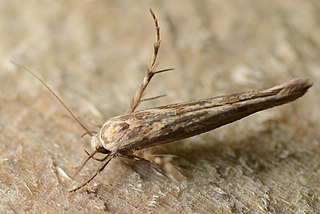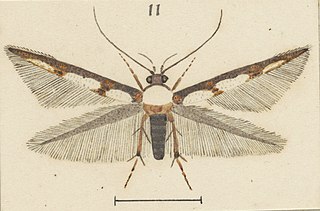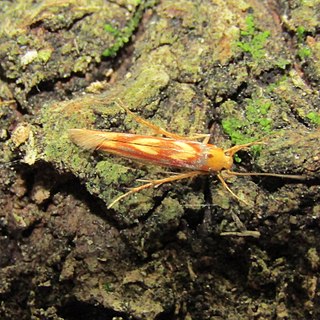
Stathmopoda melanochra is a species of moth of the family Stathmopodidae. It is found in Australia and New Zealand.

Stathmopoda is a genus of moths. It has variously been placed in its own family, Stathmopodidae, or in subfamily Stathmopodinae in the family Oecophoridae. Note that the phylogeny and systematics of gelechoid moths are still not fully resolved.

Stathmopoda margabim is a species of moth of the family Stathmopodidae. It is endemic in Réunion island in the Indian Ocean, where it can be found from medium altitudes to high altitudes of more than 1300 meters.

Stathmopoda aconias is a species of moth of the family Stathmopodidae. It is found in India and Sri Lanka.

Stathmopoda coracodes is a moth of the family Stathmopodidae. It was described by Edward Meyrick in 1923. It is found in New Zealand.
Stathmopoda endotherma is a species of moth in the family Stathmopodidae. It is endemic to New Zealand. It is classified as "At Risk, Naturally Uncommon" by the Department of Conservation.

Stathmopoda holochra is a moth of the family Stathmopodidae. It was described by Edward Meyrick in 1889 using specimens first collected at the Wellington Botanic Garden. It is endemic to New Zealand. The larvae of this species feed on Phormium seed heads.

Stathmopoda skelloni, the yellow featherfoot, is a species of moth in the Stathmopodidae family. It is endemic to New Zealand and can be found throughout the country. This species inhabits native forest, coastal dunes and shrubland as well as cultivated gardens and orchards. The larvae of this species feed on a variety of plant species including agricultural crops such as kiwifruit and persimmons. The adult moths are on the wing from September until March and are nocturnal but are attracted to light.

Stathmopoda plumbiflua is a moth of the family Stathmopodidae. It was described by Edward Meyrick in 1911 and is found in New Zealand.

Stathmopoda mysteriastis is a moth of the family Stathmopodidae. It was described by Edward Meyrick in 1901. It is found in New Zealand.

Stathmopodidae is a family of moths in the moth superfamily Gelechioidea described by Edward Meyrick in 1913.

Stathmopoda aristodoxa is a species of moth in the family Stathmopodidae. It is endemic to New Zealand. It is classified as "At Risk, Naturally Uncommon" by the Department of Conservation.
Stathmopoda diplaspis is a moth of the Stathmopodidae family. It is found in United Kingdom, Saudi Arabia, Iran, Afghanistan, Pakistan, India, Sri Lanka, Tajikistan, Afghanistan and Thailand.
Stathmopoda hexatyla is a moth of the family Stathmopodidae first described by Edward Meyrick in 1907. It is found in Sri Lanka.
Stathmopoda iners is a moth of the family Stathmopodidae first described by Edward Meyrick in 1913. It is found in Sri Lanka.
Stathmopoda masinissa, the persimmon fruit moth, is a moth of the family Stathmopodidae. The species was first described by Edward Meyrick in 1906. It is a serious pest on several persimmon species. It is found in several Old World countries Japan, Korea, Australia, Sri Lanka, Thailand and China.

Stathmopoda stimulata is a moth of the family Stathmopodidae first described by Edward Meyrick in 1913. It is found in India and Sri Lanka. Japan and Korea
Stathmopoda triloba is a moth of the family Stathmopodidae first described by Edward Meyrick in 1913. It is found in Sri Lanka.

Stathmopoda caminora is a species of moth in the family Stathmopodidae. It was first described by Edward Meyrick in 1890 and is endemic to New Zealand.
Stathmopoda cephalaea is a moth of the family Stathmopodidae. It was described by Edward Meyrick in 1897. It is found in Australia and has been recorded in New Zealand.












